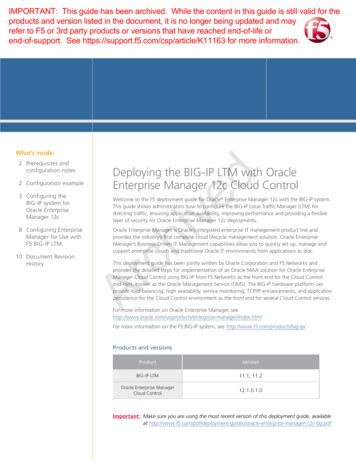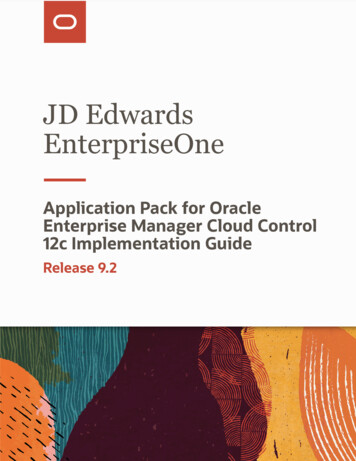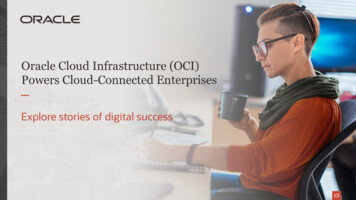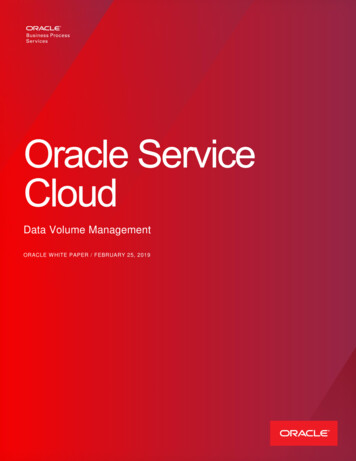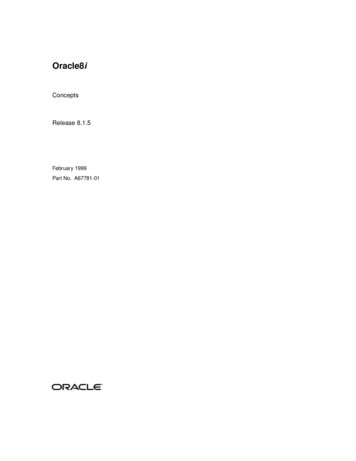
Transcription
An Oracle White PaperJune, 2013Oracle Enterprise Manager Cloud Control 12c:Complete, Integrated and Business-DrivenCloud Management1
ContentsExecutive Overview . 3Introduction . 3‘Cloud, Cloud everywhere and not a drop to drink’ . 4Complete coverage of the cloud Lifecycle . 6Plan and Setup . 7Build, Test and Deploy. 9Monitor and Manage. 12Meter, Charge and Optimize . 14Conclusion: Business Value through IT Transformation . 152
Executive OverviewCloud computing is often defined as "a style of computing in which massively scalable IT-relatedcapabilities are provided 'as a service' using Internet technologies to multiple customers." Over theyears, the benefits of cloud have become more pronounced and several IT organizations have startedembracing the model for their own data centers. Maximizing the cloud, however, requires thoroughunderstanding of IT and its business drivers. Oracle Enterprise Manager 12c is a path-breaking,transformational technology that comes with a comprehensive set of features and best practices thathelp IT transform into true, enterprise grade cloud that delivers on business needs.IntroductionModern enterprises face intense competitive pressures. Their customers have more options than ever.Enterprises must deliver new services and constantly innovate to stay ahead of the competition.However, enterprise IT is often the bottleneck. Provisioning infrastructure for new projects takes daysand weeks, instead of hours. This severely limits enterprise agility. Users, such as Developers or QAEngineers, need rapid access to development and testing platforms, without the overhead of beinggated by IT Administrators.To address these challenges, most IT organizations are exploring the benefits of cloud computingwithin their own datacenter. Whether it is faster provisioning, on demand access, agile resourcescheduling based on policies, or chargeback rules to ensure business accountability and more controlover the environment, IT must move from reactive to a proactive and predictive approach for datacenter management. Enterprise clouds cater to these needs.Enterprise Manager, Oracle’s flagship product for systems management provides industry’s mostcomplete solution for cloud management. It offers a single, integrated console for testing, deploying,operating, monitoring, diagnosing, and troubleshooting, today’s complex IT environments. It offers asimple, scalable solution for running Oracle stack, from applications to disk, in cloud environments. Itmanages everything in your datacenter - from the hypervisor to the operating system, database, andapplication tier.While Oracle Enterprise Manager offers a broad range of capabilities out-of-box, it is an extensibleplatform; while customers get comprehensive management for Oracle technology, there are connectorsand plug-ins to integrate with third-party systems. The plug-ins can manage third party IT componentssuch as Cisco and Juniper firewall and Netapp storage, while the connectors enable Enterprise Managerto share information with other management systems like IBM Tivoli, CA Unicenter and HPOpenview.cOracle Enterprise Manager Cloud Control 12 : Complete, Integrated and Business-Driven Cloud Management3
‘Cloud, Cloud everywhere and not a drop to drink’The C-word is everywhere. Today, the bustle associated with the term “cloud” has reached acrescendo. Every IT vendor has latched on to the cloud promise. Traditional Systems Managementvendors are no exceptions. However, in most cases, cloud is treated as a technology fashion, thenewest buzzword in the ever changing landscape of enterprise technology. Therefore, rather thantreating it as a lucrative technology, let us delve into what really makes a cloud, more so an enterprisegrade one, and why existing solutions fall short of addressing that market. As per the definition byNational Institute of Standards and Technology (NIST), cloud is expected to have certaincharacteristics. On-demand self-serviceResource poolingRapid elasticityMeasured ServiceService ModelsThis definition implies that cloud is not a simple self-service layer on top of existing IT automation.Resources must be pooled and modeled in an optimal way, before they are offered for self-serviceconsumption. The self-service aspect must be backed by comprehensive mechanisms for managingelasticity. Finally, resources must be metered, to enable a pay-per-user paradigm, just like the ones youare familiar with in any subscription-based service, be it cellular minutes, or streaming digital media.However, existing approaches to cloud have been by and large incomplete, often focusing on the selfservice aspect without paying any attention to the resource modeling, elasticity and metering aspects.Oracle’s cloud management solution is built from the ground up to take into account all thesecharacteristics and delivers a holistic solution for enterprises. Furthermore, while it recognizes thatcloud is the next logical next step towards achieving greater automation with lower cost, it alsoconsiders the transformational aspects of cloud. This means: Cloud planning has to be modeled into the data center consolidation strategy and not invoked asan afterthought. It may or may not entail server virtualization. While server virtualization offers asimple way of abstracting physical resources, it does create scalability as well as manageabilitychallenges. Cloud should not just become a platform for providing compute capacity, independent of businesscontext. Rather, it should be driven by business and dynamically adapt to business needs. Thisnecessitates business application provisioning and monitoring to be integrated as opposed to beingmerely supplemental. Cloud has to cater to all personas of an Enterprise, right from IT users to business users to Linesof Business sponsors. Cloud needs to be Complete, Unified and Automated. It needs to have complete coverage of thelifecycle phases (discussed later) and needs to be delivered through a single tool rather than viamultiple point tools and interfaces. Multi-console solutions in a cloud environment often fail tokeep pace with each other leading to complex synchronization and reconciliation problems.cOracle Enterprise Manager Cloud Control 12 : Complete, Integrated and Business-Driven Cloud Management4
‘Thinking beyond the V’Server virtualization is neither a necessary, nor a sufficient condition for operating a cloud.While server virtualization does offer hardware consolidation, OS-level isolation and simplified OSprovisioning via templates (aka appliances), it does not deliver a complete cloud solution. Even as aconsolidation strategy, server virtualization has limited benefits that taper out after the initialdeployment, and over time, creates challenges such as server sprawl and administrative overheads. Italso burdens DBAs and platform administrators with the requirement to manage VMs, which typicallyneed a System Administrator’s skills.Cloud can be delivered in the form of discrete services such as OS infrastructure (IaaS), as well asruntime Platforms (PaaS), such as databases (DBaaS) or Middleware (MWaaS). In addition, one canalso offer tailored services for Testing (TaaS) or deliver packaged software as services (SaaS). Servervirtualization is well suited to deliver IaaS, but falls short of delivering higher order services, such asDBaaS.Multiple architectural choices: Oracle offers a variety of architectural choices to the cloud providerto support all the aforementioned service types, in both virtual and physical environments. One candeploy multi-tier applications on virtualized servers or can deploy databases and applications on precreated platforms, whether physical or virtual. Even within the realm of virtualization, Oracle offerschoices! You can choose virtualization based on Oracle VM for x86, Oracle VM for Sparc, or SolarisContainers. Within database as a service itself, Enterprise Manager 12c provides architectural choicessuch as consolidating at the server or cluster level and consolidating using schemas at the databaselevel.Enterprise Manager 12c comes with a Service catalog rich with service templates for these differenttechnologies. Using the solution, a cloud provider can create one or more of these services andcharacterize them on size (total CPU, Memory etc.), Quality of Service (QOS), version and otherattributes that are collected during Enterprise Manager’s discovery and collection process.cOracle Enterprise Manager Cloud Control 12 : Complete, Integrated and Business-Driven Cloud Management5
Figure 1: Various architectural choices mapped to cloud servicesComplete coverage of the cloud lifecycleEnterprise Manager 12c offers functionality that spans the entire lifecycle of a cloud, and for all servicetypes that might be offered. Cloud projects typically start with extensive planning and once operational,enter a continuum of monitoring, management and optimization.Figure 2: Cloud LifecyclecOracle Enterprise Manager Cloud CoControl 12 : Complete, Integrated and Business-DrivenDriven Cloud Management6
Plan and SetupSome cloud projects are Greenfield i.e. enterprises want to start fresh cloud projects with brand newhardware, new software and in some cases, even a new data center. Other projects are brownfield innature. They are concerned with transforming existing assets into a cloud environment. It is thereforeimportant to plan out the cloud deployment model, beginning with the discovery and baselining ofexisting assets. Enterprise Manager 12c provides automated discovery capabilities that can find existingassets and manage them. It also offers a Consolidation Planner, which can provide P2P, P2V, P2Exaadvisories based upon both technical and functional constraints (such as production and test cannot beco-located).Then comes setting up the cloud. This is a very significant part of the process, especially given thatcloud is not about islands of automation on existing scripts. Enterprise Manager supports rich resourcemodels for the cloud-right from storage to applications, for both physical and virtualized infrastructure,so that the enterprise can maximize the benefits of consolidation and cloud. Enterprise Manager 12coffers capabilities such as bare metal provisioning of Hypervisor, setting up of server and storage poolsand grouping them into zones based on functional or QOS characteristics. Enterprise Manager alsoleverages Virtualization Storage Connect technology, where the cloud setup process integrates withbest-of-breed storage technologies like Netapp, Hitachi, Fujitsu.Oracle Enterprise Manager is industry’s first solution that has the ability model not only infrastructureas a service (IaaS) but also platform as a service anddatabase as a service clouds, from a single console. It allowsAdministrators to define standardized service templates fordatabases and middleware platforms, and publish these asservices. Administrators can create different types ofservices depending upon the business needs. For example,Administrators may offer a database service based ondifferent versions of Oracle middleware, but only the onesapproved for use within the business.Enterprise Manager also comes with a sophisticatedframework to enable role-driven access control as well asthe resource limits for the self-service users that consumethe service. Integration with LDAP allows Enterprise manager to inherit enterprise roles. The resourcelimits are implemented with quotas that are tailored for the specific service type (IaaS, PaaS andDBaaS). This prevents rogue usage of a service while also preventing a few users from devouringmajority of the resources in the cloud.cOracle Enterprise Manager Cloud Control 12 : Complete, Integrated and Business-Driven Cloud Management7
Figure 3: Cloud architectureSo, what do the Administrators need to do? As discussed before, the Administrators are in the businessof cloud enablement, for which Enterprise Manager 12c ships with out-of-box roles such as cloudAdministrator and Self-Service Administrator. Enterprise Manager 12c also provides out-of-boxautomation for these roles. The cloud Administrator can set up the cloud infrastructure, such asservers, storage and database pools, and group them into Zones. The Self-Service Administrator thendefines access controls, quota, retirement policies and the charge plans with the service and releases theservice in the self-service catalog.Enterprise Manager12c also provides programmatic interfaces (EMCLI) for setting up the cloud.Integrators can use those to create a cloud and scale it up based on needs.cOracle Enterprise Manager Cloud Control 12 : Complete, Integrated and Business-Driven Cloud Management8
Figure 4: Enterprise Manager enabled cloud setup activitiesBuild, Test and DeployA sophisticated private cloud solution needs to cater to a variety of use cases: A developer or a project owner requiring a new application service with or without seed data QA requiring a full clone for intense load testing QA requiring to create multiple clones for functional testing on subset of dataThe current release of Oracle Enterprise Manager Cloud Control 12c offers new capabilities andsupport for managing database cloud services in all the above cases. It comes with out-of-boxcapabilities for infrastructure as a service and platform as a service including database as a service. Forinfrastructure as a service, it can deploy VM templates or assemblies. For database as a service, it offerschoices such as schema as a service for extreme database consolidation and database cloning throughSnap Clone or RMAN Backups. These capabilities provide an optimum utilization of development anddatabase resources, giving customers more flexibility and control in managing the database lifecycle.One big consumer group of cloud is QA Engineers or Testers. They perform User Acceptance Tests(UAT) for various applications. To perform an UAT, they need to create copies of the productiondatabase. For intense testing, such as in pre-upgrade scenarios, they need a full updateable copy of theproduction data. There are other situations, such as in functional testing, they need to perform minimalupdates to the data, but at the same time, need multiple functional copies. Enterprise Manager 12csupports both the scenarios. In the former case, it leverages RMAN backups to clone the data. In thelatter case, it leverages the “Copy on Write” technology at the storage layer to perform EnterpriseManager 12c Snap Clone (or just Snap Clone). Currently, NAS technologies viz. Netapp and ZFSStorage Appliance are supported for Snap Clone. By using this technology, the entire data does notneed to be cloned, but the new database can physically point to the source blocks within the same filerand only needs to allocate new blocks if there are updates to the cloned copy.cOracle Enterprise Manager Cloud Control 12 : Complete, Integrated and Business-Driven Cloud Management9
The following picture highlights the various use cases of DBaaS that Oracle Enterprise Manageraddresses. While each of these has specific applicability, Oracle Enterprise Manager handles all theseuse cases comprehensively.Figure 5: various use cases supported by Enterprise Manager’s DBaaSDeploying application in the cloud poses interesting challenges. The traditional model has been whereone deploys various components of the application individually and then manually wires them together.The problem gets aggravated by other deployment constraints – such as different network segmentsfor each application tier.Oracle Enterprise Manager is unique in addressing thischallenge. It leverages Oracle Virtual Assembly Builder(OVAB) to package the application and its relationships ina single metadata driven deployment unit. Using OVAB,application developers and architects can model theapplication topology graphically, define all dependenciesand deployment constraints, and deliver the entireapplication in form of an application “assembly”. Theassembly can then be published to the centralized softwarelibrary in Enterprise Manager, be made available to otherusers for self-service deployments. For users who simplywant to deploy Java applications on a pre-existingplatform, Enterprise Manager provides a simple, easy-to-use solution that provides the necessarycOracle Enterprise Manager Cloud Control 12 : Complete, Integrated and Business-Driven Cloud Management10
abstraction and simplicity to deploy an application, associate it with data sources and monitor itshealth.Oracle Enterprise Manager 12c also includes a higher order service tailored for testing. Testing as aService, a new cloud platform for delivering automated application testing services, includes a selfservice solution that orchestrates the testing process end-to-end by automating provisioning ofcomplete test labs (applications, test tools and assets comprising scripts and scenarios), execution ofload and functional tests and rich application monitoring and diagnostics. It also includes asophisticated chargeback facility and the ability to perform deeper diagnostics in context of testing.Enterprise Manager 12c comes with an out-of-box yet customizable self-service Application that letsend-users deploy a wide range of these services. End users can choose to provision applicationassemblies, along with databases and platforms, all in on-demand fashion. . For each request, they canspecify the amount of underlying resources (CPU, memory, etc) that they require for each component.Enterprise Manager automatically provisions the requested service and the appropriate resources.Once you build an application, you need to test it. Enterprise Manager 12c carries a complete testingportfolio that allows users to test both application changes and the changes database or lower level. Avery unique aspect of the testing solution is the ability to capture a production load and replay in a testenvironment, so that the results are predictable. The testing solution also leverages the deep diagnosticcapabilities built into the technology layers and provides prescriptions for remediation.Enterprise Manager 12c comes with an out-of-box yet customizable self-service application that letsend-users deploy a wide range of these services. End users can choose to provision applicationassemblies, along with databases and platforms, all in on-demand fashion. . For each request, they canspecify the amount of underlying resources (CPU, memory, etc.) that they require for each component.Enterprise Manager automatically provisions the requested service and the appropriate resources. Theself-service application also lets users define policies to scale out or scale back resources based onschedule or performance metrics. For example, one can set a policy to elastically scale out a web serverif the processor load on existing web servers exceeds a certain threshold value.Thus, Enterprise Manager enables a layer of abstraction that hides the underlying complexities of theapplication from the end-user. This abstraction is delivered via a self-service interface, both in graphical(GUI) and programmatic (API) variants. Enterprise Manager cloud APIs are RESTFUL in nature.cOracle Enterprise Manager Cloud Control 12 : Complete, Integrated and Business-Driven Cloud Management11
Figure 6: Out-of-box cloud self-service portalMonitor and ManageOnce a cloud has been commissioned, it has to be monitored and managed. Over the years, theindustry has witnessed superficial service level monitoring and fragmented management of individualcomponents. Enterprise Manager 12c fundamentally transforms this by following an Application to Diskparadigm, which a) monitors all components through a single pane of glass, and b) provides deep, outof-box capabilities that are instrumented in the base product and proven to reduce problem resolutiontime by more than 50%. The ultimate manifestation of the Application to Disk Management paradigmcomes in the form of management of engineered systems such as Exadata and Exalogic.In a cloud the monitoring framework has to scale to thousands of servers, databases and middlewaretargets. Enterprise Manager 12c provides the ability to collate the targets into groups for bettermanageability. The new Administration Group feature lets administrators define monitoring settings,compliance standards and cloud policies through templates and also organize the each target inmultiple hierarchies, such as Line of Business and Lifecycle status. Enterprise Manager 12c also comeswith an in-built Incident Management system that can manage by exceptions. Administrators canreview, suppress, escalate and remediate the events as needed, and also integrate it with ticketingsystems.Enterprise Manager 12c has the ability to define contractual Service Level Agreements (SLAs) thatgovern the contract between the application owner and the provider of the cloud. Administrators aswell as users can also define management policies that automatically adjust the service resources toensure that SLAs are met.cOracle Enterprise Manager Cloud Control 12 : Complete, Integrated and Business-Driven Cloud Management12
Also, while most tools focus only on the stack management aspects of cloud infrastructure, EnterpriseManager also provides user experience management and business transaction management. Bolsteredby acquired technologies in these areas, EnterpriseManager is the leading solution for ensuring applicationperformance in the cloud.A management requirement often overlooked in the cloudcontext is that of Configuration Management. The agilityand elasticity (such as VM Migration) in a cloud demandreal-time discovery of and synchronization with fastchanging system topologies, thereby rendering traditionalConfiguration Management deficient.Unlike thesesolutions, Enterprise Manager 12c ConfigurationManagement capabilities are optimized for cloudenvironments. It can monitor vast numbers ofconfigurations continuously, discover changes, measuredrifts, pin-point configuration errors, as well as offer insight into system topologies, all within a singlepane of glass!Finally, the cloud management capabilities are also integrated with My Oracle Support. This integrationdelivers facilities such as Patch Advisories, Service Request Management, Knowledge Managementright on-premise and in-context of the overall cloud.Figure 6: Business Driven Application ManagementcOracle Enterprise Manager Cloud Control 12 : Complete, Integrated and Business-Driven Cloud Management13
Meter, Charge and OptimizeShared services and clouds bring some additional challenges for IT. As different tenants start sharingthe same piece of platform or infrastructure, they need to be accountable for their respective usage,else a few individuals might consume majority of the resources. Also, the very ease of self-serviceprovisioning may lead to over-consumption of resources,and result in a. To mitigate this, organizations must meterthe usage and optionally chargeback [also known asshowback] the tenants. Though money may not tradehands, this provides IT as well as the LOBs, costtransparency on an ongoing basis.Enterprise manager 12c is equipped with sophisticated andflexible Metering and Chargeback mechanisms. Unlikeexisting chargeback tools that solely focus on basiccompute metrics like CPU, memory and storage usage, ITcan define pricing models based on application usage,database usage and middleware-level metrics. Also, theycan extend pricing models to account for fixed costs, configurations, administrative expenses, peoplecosts, energy utilization or a combination of these. The chargeback application also supports latest andgreatest database consolidation technologies, such as pluggable databases.These capabilities enable enterprise to account for actual usage versus representative usage.Figure 7: Chargeback reportingcOracle Enterprise Manager Cloud Control 12 : Complete, Integrated and Business-Driven Cloud Management14
cloud management also entails an ongoing optimization of resources as well processes to make sure theservice levels are persistent. Enterprise Manager 12c is rich in features that help rediscover assets, reevaluate the performance, rebalance the cloud, and fine tune the provisioning process. The tuningcapabilities in the operating system, database and middleware layers aid in continuous optimization andsubsequent improvement.Conclusion: Business Value through IT TransformationFor IT to truly support the business – which is, after all, the purpose of enterprise cloud computing – itneeds to transform itself into an organization that lets business users consume IT services on demand,reduces complexity in existing IT and manages IT from a business perspective.Oracle enjoys the strategic advantage in its ability to fulfill the promise of cloud computing, given itsindustry leadership and its ability to offer the entire software and systems stack, ranging frominfrastructure to development platforms, to databases and business applications, necessary to build,deploy and operate an enterprise cloud. The Oracle cloud stack and Oracle Enterprise Manager CloudControl 12c deliver to all of the requirements through built-in manageability.Experience Total Cloud Control, and transform both your business and IT together.cOracle Enterprise Manager Cloud Control 12 : Complete, Integrated and Business-Driven Cloud Management15
Copyright 2011, Oracle and/or its affiliates. All rights reserved. This document is provided for information purposes only and thecontents hereof are subject to change without notice. This document is not warranted to be error-free, nor subject to any otherAuthors: Sudip Datta, Dhruv GuptaOctober, 2011warranties or conditions, whether expressed orally or implied in law, including implied warranties and conditions of merchantability orfitness for a particular purpose. We specifically disclaim any liability with respect to this document and no contractual obligations areformed either directly or indirectly by this document. This document may not be reproduced or transmitted in any form or by anyOracle Corporationmeans, electronic or mechanical, for any purpose, without our prior written permission.World Headquarters500 Oracle ParkwayOracle and Java are registered trademarks of Oracle and/or its affiliates. Other names may be trademarks of their respective owners.Redwood Shores, CA 94065U.S.A.AMD, Opteron, the AMD logo, and the AMD Opteron logo are trademarks or registered trademarks of Advanced Micro Devices.Worldwide Inquiries:and are trademarks or registered trademarks of SPARC International, Inc. UNIX is a registered trademark licensed through X/OpenPhone: 1.650.506.7000Company, Ltd. 1010Intel and Intel Xeon are trademarks or registered trademarks of Intel Corporation. All SPARC trademarks are used under licenseFax: 1.650.506.7200oracle.com
Oracle Enterprise Manager Cloud Control 12 c: Complete, Integrated and Business-Driven Cloud Management 4 'Cloud, Cloud everywhere and not a drop to drink' The C-word is everywhere. Today, the bustle associated with the term "cloud" has reached a crescendo. Every IT vendor has latched on to the cloud promise. Traditional Systems Management
![[1]Oracle Enterprise Manager Cloud Control Basic Installation Guide .](/img/34/e22624.jpg)

